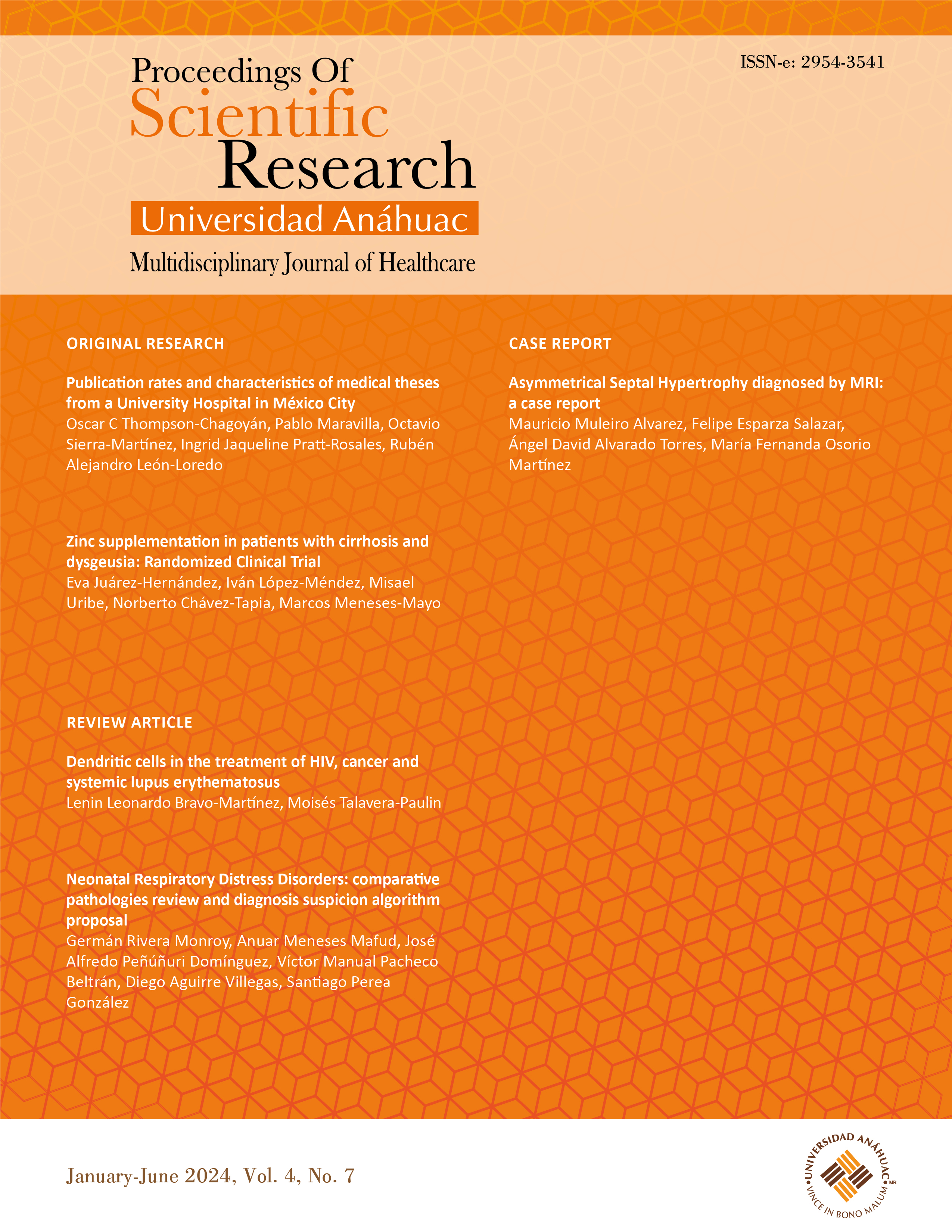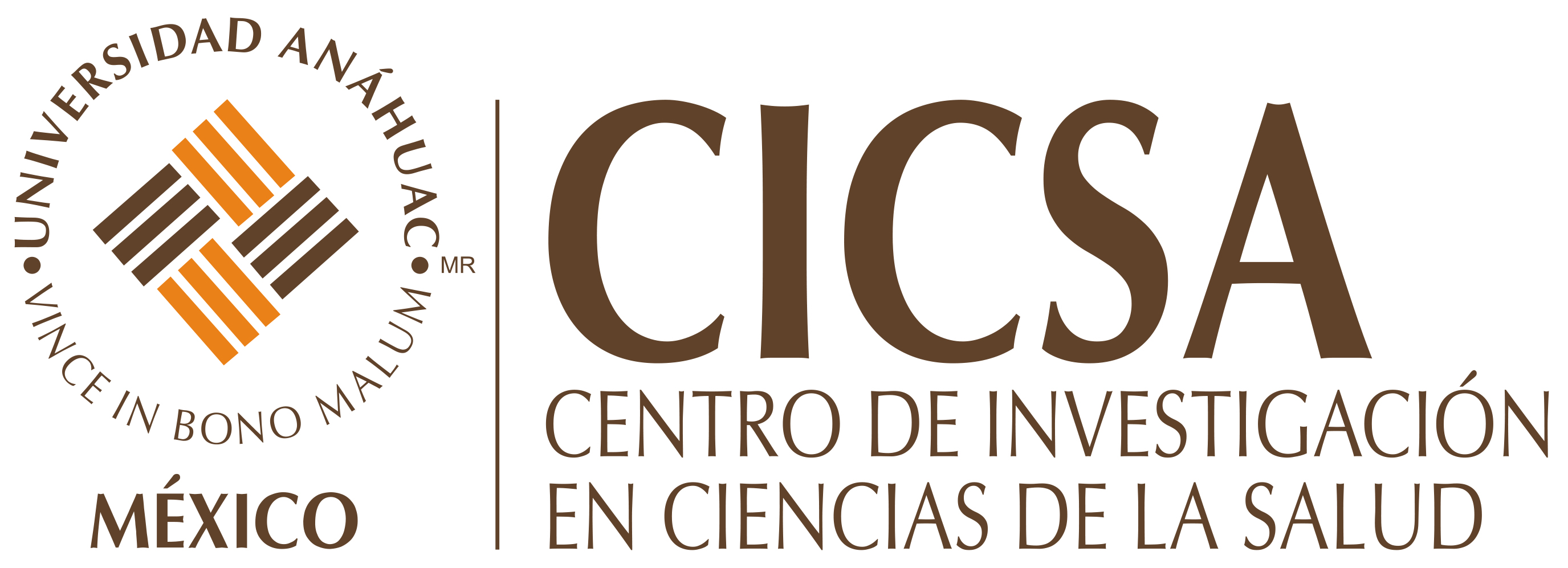Asymmetrical Septal Hypertrophy diagnosed by MRI: a case report
DOI:
https://doi.org/10.36105/psrua.2024v4n7.05Keywords:
asymmetric septal hypertrophy, sarcomere, sudden death, syncopeAbstract
Asymmetrical septal hypertrophy (ASH) is defined as an increase in ventricular wall thickness greater than 15 mm that is not associated with any other pathology. It is a condition that, in most cases, is caused by a mutation in one of the genes associated with the proteins that form the sarcomere. In this article, we present a case of ASH in a 43-year-old adult. After manifesting tachypnea, dyspnea, and cutaneous pallor, followed by a syncopal episode, the individual seeks medical attention. During the medical evaluation, an electrocardiogram (ECG) is performed, revealing bradycardia at 48 beats per minute and an inverted T wave in leads DI, AVL, V3, V4, V5, and V6. The diagnosis is confirmed through cardiac magnetic resonance imaging, which shows hypertrophic cardiomyopathy with non-obstructive ASH of 27.22 mm. Consequently, it is decided to initiate pharmacological treatment with propranolol, and the patient is still awaiting a surgical timeframe for the placement of an implantable cardioverter-defibrillator (ICD).
Downloads
PLUMX metrics
References
Schaufelberger M. Cardiomyopathy and pregnancy. Heart. 2019;105(20):1543-1551. https://pubmed.ncbi.nlm.nih.gov/31308064/ DOI: https://doi.org/10.1136/heartjnl-2018-313476
Gowda SN, Ali HJ, Hussain I. Overview of Restrictive Cardiomyopathies. Methodist Debakey Cardiovasc J. 2022;18(2):4-16. https://pubmed.ncbi.nlm.nih.gov/35414858/ DOI: https://doi.org/10.14797/mdcvj.1078
Sebastian SA, Panthangi V, Singh K, Rayaroth S, Gupta A, Shantharam D, Rasool BQ, Padda I, Co EL, Johal G. Hypertrophic Cardiomyopathy: Current Treatment and Future Options. Curr Probl Cardiol. 2023;48(4):101552. https://doi.org/10.1016/j.cpcardiol.2022.101552 DOI: https://doi.org/10.1016/j.cpcardiol.2022.101552
Biddinger KJ, Jurgens SJ, Maamari D, Gaziano L, Choi SH, Morrill VN, Halford JL, Khera AV, Lubitz SA, Ellinor PT, Aragam KG. Rare and Common Genetic Variation Underlying the Risk of Hypertrophic Cardiomyopathy in a National Biobank. JAMA Cardiol. 2022;7(7):715-722. https://doi.org/10.1001/jamacardio.2022.1061 DOI: https://doi.org/10.1001/jamacardio.2022.1061
Ottaviani A, Mansour D, Molinari LV, Galanti K, Mantini C, Khanji MY, Chahal AA, Zimarino M, Renda G, Sciarra L, Pelliccia F, Gallina S, Ricci F. Revisiting Diagnosis and Treatment of Hypertrophic Cardiomyopathy: Current Practice and Novel Perspectives. J Clin Med. 2023;12(17):5710. https://doi.org/10.3390/jcm12175710 DOI: https://doi.org/10.3390/jcm12175710
Litt MJ, Ali A, Reza N. Familial Hypertrophic Cardiomyopathy: Diagnosis and Management. Vasc Health Risk Manag. 2023;19:211-221. https://doi.org/10.2147/VHRM.S365001 DOI: https://doi.org/10.2147/VHRM.S365001
Kochi AN, Vettor G, Dessanai MA, Pizzamiglio F, Tondo C. Sudden cardiac death in athletes: From the basics to the practical work-up. Medicina. 2021;57(2):168. https://doi.org/10.3390/medicina57020168 DOI: https://doi.org/10.3390/medicina57020168
Márquez MF, Ruíz-Siller TJ, Méndez-Ramos R, Karabut E, Aranda-Fraustro A, Jiménez-Becerra S. Miocardiopatía hipertrófica (MCH). Una revisión histórica y anatomopatológica. Gac Med Mex. 2016;152(5):697-702. Available from: https://www.medigraphic.com/cgi-bin/new/resumen.cgi?IDARTICULO=68916
Veselka J, Anavekar NS, Charron P. Hypertrophic obstructive cardiomyopathy. Lancet. 2017;389(10075):1253-1267. https://doi.org/10.1016/S0140-6736(16)31321-6 DOI: https://doi.org/10.1016/S0140-6736(16)31321-6
Bayonas-Ruiz A, Muñoz-Franco FM, Sabater-Molina M, Oliva-Sandoval MJ, Gimeno JR, Bonacasa B. Current therapies for hypertrophic cardiomyopathy: a systematic review and meta-analysis of the literature. ESC Heart Fail. 2023;10(1):8-23. https://doi.org/10.1002/ehf2.14142 DOI: https://doi.org/10.1002/ehf2.14142
Ozdemir S, Tan YZ, Gazi E. Is the Increased Septal Perfusion the Signal of Asymmetrical Septal Hypertrophy? World J Nucl Med. 2016;15(3):184-9. https://doi.org/10.4103/1450-1147.174706 DOI: https://doi.org/10.4103/1450-1147.174706
Kuznetsov VA, Yaroslavskaya EI, Zyrianov IP, Kolunin GV, Krinochkin DV, Bessonova MI, Bessonov IS. Asymmetric septal hypertrophy in patients with coronary artery disease. Eur J Echocardiogr. 2010;11(8):698-702. https://doi.org/10.1093/ejechocard/jeq046 DOI: https://doi.org/10.1093/ejechocard/jeq046
Tuseth N, Cramariuc D, Rieck AE, Wachtell K, Gerdts E. Asymmetric septal hypertrophy - a marker of hypertension in aortic stenosis (a SEAS substudy). Blood Press. 2010;19(3):140-4. https://doi.org/10.3109/08037051.2010.481816 DOI: https://doi.org/10.3109/08037051.2010.481816
Melas M, Beltsios ET, Adamou A, Koumarelas K, McBride KL. Molecular Diagnosis of Hypertrophic Cardiomyopathy (HCM): In the Heart of Cardiac Disease. J Clin Med. 2022;12(1):225. https://doi.org/10.3390/jcm12010225 DOI: https://doi.org/10.3390/jcm12010225
Weissler-Snir A, Crean A, Rakowski H. The role of imaging in the diagnosis and management of hypertrophic cardiomyopathy. Expert Rev Cardiovasc Ther. 2016;14(1):51-74. https://doi.org/10.1586/14779072.2016.1113130 DOI: https://doi.org/10.1586/14779072.2016.1113130
Tschöpe C, Cooper LT, Torre-Amione G, Van Linthout S. Management of Myocarditis-Related Cardiomyopathy in Adults. Circ Res. 2019;124(11):1568-1583. https://doi.org/10.1161/CIRCRESAHA.118.313578 DOI: https://doi.org/10.1161/CIRCRESAHA.118.313578
Gragnano F, Pelliccia F, Guarnaccia N, Niccoli G, De Rosa S, Piccolo R, Moscarella E, Fabris E, Montone RA, Cesaro A, Porto I, Indolfi C, Sinagra G, Perrone Filardi P, Andò G, Calabrò P; Working Group of Interventional Cardiology of the Italian Society of Cardiology. Alcohol Septal Ablation in Patients with Hypertrophic Obstructive Cardiomyopathy: A Contemporary Perspective. J Clin Med. 2023;12(8):2810. https://doi.org/10.3390/jcm12082810 DOI: https://doi.org/10.3390/jcm12082810
Grillo MP, Erve JCL, Dick R, Driscoll JP, Haste N, Markova S, Brun P, Carlson TJ, Evanchik M. In vitro and in vivo pharmacokinetic characterization of mavacamten, a first-in-class small molecule allosteric modulator of beta cardiac myosin. Xenobiotica. 2019;49(6):718–733. https://doi.org/10.1080/00498254.2018.1495856 DOI: https://doi.org/10.1080/00498254.2018.1495856
Dong T, Alencherry B, Ospina S, Desai MY. Review of Mavacamten for Obstructive Hypertrophic Cardiomyopathy and Future Directions. Drug design, development and therapy. 2023;17, 1097–1106. https://doi.org/10.2147/DDDT.S368590 DOI: https://doi.org/10.2147/DDDT.S368590
Keam SJ. Mavacamten: First Approval. Drugs, 2022;82(10), 1127–1135. https://doi.org/10.1007/s40265-022-01739-7 DOI: https://doi.org/10.1007/s40265-022-01739-7
Heitner SB, Jacoby D, Lester, SJ, Owens A, Wang A, Zhang D, Lambing J, Lee J, Semigran M, Sehnert AJ. Mavacamten Treatment for Obstructive Hypertrophic Cardiomyopathy: A Clinical Trial. Annals of internal medicine, 2019;170(11), 741–748. https://doi.org/10.7326/M18-3016 DOI: https://doi.org/10.7326/M18-3016
Olivotto I, Oreziak A, Barriales-Villa R, Abraham TP, Masri A, Garcia-Pavia P, Saberi S, Lakdawala NK, Wheeler MT, Owens A, Kubanek M, Wojakowski W, Jensen MK, Gimeno-Blanes J, Afshar K, Myers J, Hegde S M, Solomon SD, Sehnert AJ, Zhang D, Li W, Bhattacharya M, Edelberg JM,Burstein-Waldman C, Lester SJ, Wang A, Ho CY, Jacoby D, EXPLORER-HCM study investigators. Mavacamten for treatment of symptomatic obstructive hypertrophic cardiomyopathy (EXPLORER-HCM): a randomised, double-blind, placebo-controlled, phase 3 trial. Lancet, 2020;396(10253):759–769. https://doi.org/10.1016/S0140-6736(20)31792-X DOI: https://doi.org/10.1016/S0140-6736(20)31792-X
Desai MY, Owens A, Geske JB, Wolski K, Naidu SS, Smedira NG, Cremer PC, Schaff H, McErlean E, Sewell C, Li W, Sterling L, Lampl K, Edelberg JM, Sehnert AJ, Nissen SE. Myosin inhibition in patients with obstructive hypertrophic cardiomyopathy referred for septal reduction therapy. J Am Coll Cardiol. 2022;80(2):95–108. https://doi.org/10.1016/j.jacc.2022.04.048 DOI: https://doi.org/10.1016/j.jacc.2022.04.048

Published
How to Cite
Issue
Section
License
Copyright (c) 2024 Mauricio Muleiro Álvarez, Felipe Esparza Salazar, Ángel David Alvarado Torres, María Fernanda Osorio Martínez

This work is licensed under a Creative Commons Attribution-NonCommercial-NoDerivatives 4.0 International License.
All the intellectual content found in this publication is licensed to the consumer public under the figure of Creative Commons©, unless the author of said content has agreed otherwise or limited said faculty to "Proceedings of Scientific Research Universidad Anáhuac. Multidisciplinary Journal of Healthcare©" or "Universidad Anáhuac Mexico©" in writing and expressly.
Proceedings of Scientific Research Universidad Anáhuac. Multidisciplinary Journal of Healthcare is distributed under a Creative Commons Attribution-NonCommercial-NoDerivatives 4.0 International License.
The author retains the economic rights without restrictions and guarantees the journal the right to be the first publication of the work. The author is free to publish his article in any other medium, such as an institutional repository.












